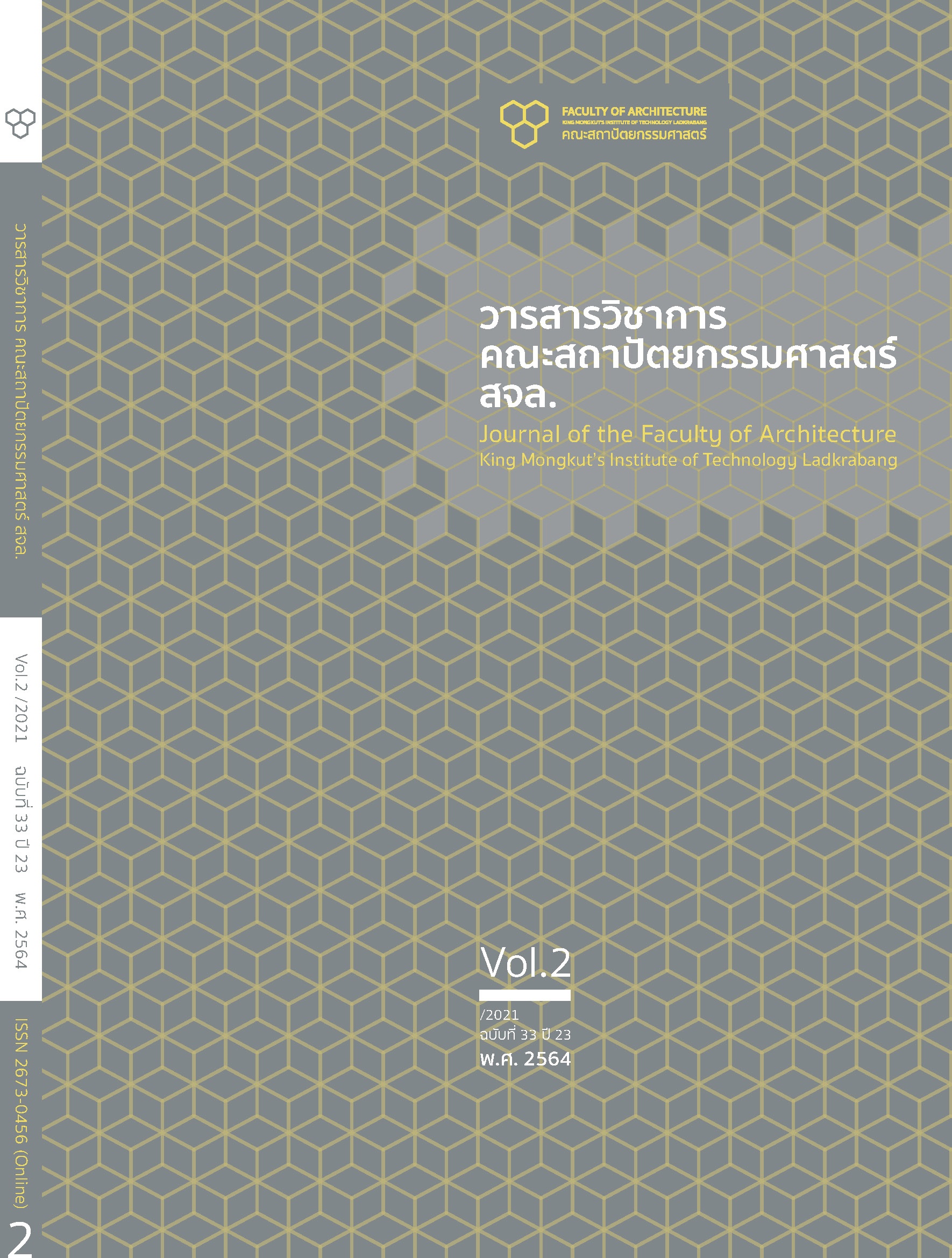ผลของระบบเชื่อมต่อโครงสร้างด้วยวิธีการเข้าไม้เพื่อการออกแบบของเล่นในทัศนะของผู้เชี่ยวชาญ
Main Article Content
บทคัดย่อ
งานวิจัยนี้มีวัตถุประสงค์เพื่อศึกษา และหาแนวทางการออกแบบระบบเชื่อมต่อโครงสร้างด้วยวิธีการเข้าไม้ด้วยวิธีการล็อกด้วยการเข้าไม้แบบต่าง ๆ สำหรับประกอบชิ้นงานไม้แทนนอตหรือสกรู โดยนำไปใช้ประโยชน์ในการพัฒนาวิธีการเข้าไม้ เพื่อใช้ประโยชน์ในอุตสาหกรรมการผลิตของเล่น สร้างคุณลักษณะใหม่ในการประกอบชิ้นงานและสร้างรูปลักษณ์ของผลิตภัณฑ์ให้น่าสนใจด้วยวิธีการล็อก ตลอดจนเป็นประโยชน์ต่อการเรียนการสอนวิชาการออกแบบอุตสาหกรรมศิลป์ จึงเป็นที่มาในการออกแบบและพัฒนาระบบโครงสร้างการเข้าไม้ที่มีการล็อกโครงสร้างด้วยตัวเองโดยใช้แผ่นใยไม้อัดความหนาแน่นปานกลางเป็นวัสดุหลักในการวิจัย โดยวิเคราะห์รูปแบบการเข้าไม้ด้วยการวิเคราะห์เมทริกซ์ และเมทริกซ์การตัดสินใจ การใช้ระเบียบวิธีวิจัยด้วยการวิเคราะห์ส่วนได้ส่วนเสีย โดยใช้โปรแกรมสำเร็จรูป NAKAYA บนไมโครซอฟต์ เอ็กเซล และแบบสอบถามความคิดเห็นผู้เชี่ยวชาญ ซึ่งวิเคราะห์ข้อมูลด้วยการเปรียบเทียบแบบเป็นคู่ ผลการวิจัยพบว่า 1) การเข้าไม้ด้วยวิธีการล็อกแบบ Slot taper joint มีคุณลักษณะสำคัญที่โดดเด่นในทุกด้าน คือ ด้านโครงสร้างมีความเสถียรและไม่โคลงเคลง ด้านการใช้งานที่ประกอบง่าย ด้านรูปปรากฏที่มีความงาม และด้านความยืดหยุ่นที่มีจำนวนชิ้นส่วนที่เหมาะสมในการปรับใช้กับพื้นผิววัสดุอื่น 2) การเข้าไม้ด้วยวิธีการล็อกแบบ Slot clip joint มีคุณลักษณะสำคัญในด้านรูปปรากฏที่มีเอกลักษณ์ของการล็อกที่โดดเด่น ดูมีราคา และมีมูลค่า และ3) การเข้าไม้ด้วยวิธีการล็อกแบบ Slot halved joint มีคุณลักษณะสำคัญในด้านความยืดหยุ่นที่มีจำนวนชิ้นที่เหมาะสม
Article Details
This work is licensed under a Creative Commons Attribution-NonCommercial-ShareAlike 4.0 International License.
Copyright Transfer Statement
The copyright of this article is transferred to Journal of The Faculty of Architecture King Mongkut's Institute of Technology Ladkrabang with effect if and when the article is accepted for publication. The copyright transfer covers the exclusive right to reproduce and distribute the article, including reprints, translations, photographic reproductions, electronic form (offline, online) or any other reproductions of similar nature.
The author warrants that this contribution is original and that he/she has full power to make this grant. The author signs for and accepts responsibility for releasing this material on behalf of any and all co-authors.
References
กรมเสริมการค้าระหว่างประเทศ. (2564). DITP แนะผู้ผลิต ผู้ส่งออก วางแผนขยายตลาดของเล่น-อุปกรณ์กีฬาในสหรัฐฯ. เข้าถึงได้จาก: https://gnews.apps.go.th/news?news=78348.
พรเทพ เลิศเทวศิริ. (2533). องค์ประกอบในการออกแบบของเล่นเพื่อการศึกษาสำหรับเด็กปฐมวัยในทัศนะของผู้เชี่ยวชาญ. (วิทยานิพนธ์ปริญญามหาบัณฑิต สาขาวิชาศิลปศึกษา ภาควิชาศิลปศึกษา, จุฬาลงกรณ์มหาวิทยาลัย).
พรเทพ เลิศเทวศิริ. (2545). Design education 1: รวมบทความและรายงานการวิจัยศาสตร์แห่งการออกแบบ. กรุงเทพฯ: สำนักพิมพ์จุฬาลงกรณ์มหาวิทยาลัย.
พรเทพ เลิศเทวศิริ. (2560). สถิติการเปรียบเทียบแบบเป็นคู่ (Paired comparison). เอกสารประกอบการสอนวิชาการออกแบบอุตสาหกรรมศิลป์.
อดิศักดิ์ ผลิตผลการพิมพ์. (2548). อันตรายจากของเล่น. นิตยสารหมอชาวบ้าน. (311).
เอกกมล เอี่ยมศรี (ผู้รวบรวม). (2564). กลยุทธ์ข้อมูลองค์กร (Data Strategy). เข้าถึงได้จาก: https://eiamsri.wordpress.com.
Chakrabarti, A. (1999). A product design principle. International Conference on Engineering Design ICED 99, Munich, August 24 -26, 1999.
Crilly, N., Moultrie, J., and Clarkson, P. J. (2004). Seeing things: consumer response to the visual domain in product design. Design Studies, 25(6), 547–577.
Elemer, M.L. and Tamas, F. (2002). Finite element analysis of cross halved joints for structural composites. The Society of Wood Science and Technology. 34(2), 2002, 251-265.
Forestresearch (2011). Trade-off analysis. Retrieved from: https://www.forestresearch.gov.uk/documents/2405/Toolbox_May2011_Trade_off_analysis.pdf.
Gary, R. (2020). The complete illustrated guide to joinery. Retrieved from: https://www.woodworking-camp.com/2020/03/complete-illustrated-guide-to-joinery.html
Janell D.T., Mitzi M.M., and Roger J.C. (2011). Form and Function: A Matter. Journal of Product Innovation Management. 28(3), 374-377.
Liedtka, J. and Ogilvie T. (2020). Designing for Growth: A design thinking tool kit for managers. Columbia business school publishing.
Mario, R. (2019). 11 Mortise and Tenon Variations. Retrieved from: https://www.finewoodworking.com/2019/02/11/11-mortise-and-tenon-variations.
Mark, M. (2014). CNC Cut Wood Joinery. Retrieved from: http://mkmra2.blogspot.com/2014/08/cnc-cut-wood-joinery.html.
Post, R.A.G., Blijlevens, J., and Hekkert, P. (2016). ‘To preserve unity while almost allowing for chaos’: Testing the aesthetic principle of unity-in-variety in product design. Acta Psychologica, 163, 142-152.
Ride Toy Zone. (2021). The Different Types Of Ride On Toy Cars For Kids. Retrieved from: https://ridetoyzone.com/types-of-ride-on-toy-cars.
Solomon, M. R. (1983). The role of products as social stimuli: A symbolic interactionism perspective. Journal of Consumer Research 10(3), 319–329.
Sylcott, B., Cagan, J., and Tabibnia, G. (2011). Understanding of emotions and reasoning during consumer tradeoff between function and aesthetics in product design. Proceedings of the ASME International Design Engineering Technical Conferences & Computers and Information in Engineering Conference IDETC/CIE 2011, Washington, DC, USA, August 28-31.
Ted, R. (2019). Loose-Wedge Mortise & Tenon Joints. Retrieved from: https://www.woodsmith.com/article/loose-wedge-mortise-tenon-joints-basic-tusk-tenon.
Wazzadu. (2560). ไม้ MDF BOARD (Medium Density FiberBoard) กับคุณสมบัติที่น่ารู้ก่อนจะนำเอาไปใช้งาน. เข้าถึงได้จาก: https://www.wazzadu.com/article/1209.
Yamanaka, T. (1997). Designing with left brain explore scientific design. Kaibundo Publishing, Tokyo.

